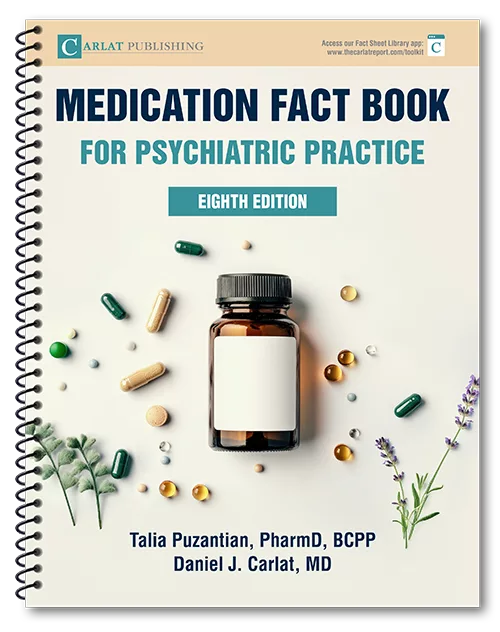Home » Psychopharmacology in Bipolar II
Psychopharmacology in Bipolar II
March 9, 2020
From The Carlat Psychiatry Report
 Tammas Kelly, MD
Tammas Kelly, MD
Psychiatrist in private practice in Fort Collins, CO. Author of The Art and Science of Thyroid Supplementation for the Treatment of Bipolar Depression (2018) Dr. Kelly has disclosed that he has no relevant financial or other interests in any commercial companies pertaining to this educational activity.
TCPR: You’ve carved out a unique practice with difficult-to-treat bipolar disorders. Tell us about the patients you see.
Dr. Kelly: I see a lot of bipolar II and “softer bipolar.” Clinically these patients have chronic depression, often mixed with hypomanic symptoms. Nearly all have tried multiple antidepressants that didn’t work, stopped working, or made their mood worse. They don’t look like the textbook bipolar case. It’s hard to see “two poles” because the hypomanic symptoms are usually mixed in with depression, anxiety, and irritability. Many had their last clear hypomanic episodes 20 years ago. Some might even be classified in the DSM-5 as unipolar, under the new category “Major depression with mixed features.”
TCPR: So you’re not seeing the textbook case. Are these rare cases?
Dr. Kelly: No. It’s actually the patients with classic, euphoric hypomania who are relatively rare. So it’s easy to miss a case of bipolar if you’re just looking for euphoria. You have to look for other clues—like family history, treatment response, and mixed features—otherwise, most bipolar II patients just look like chronic relapsing depression. Patients with bipolar II spend 1.3% of their lives in pure hypomania and about 50% of their lives in depression, according to a 13-year study with weekly mood ratings (Judd LL et al, Arch Gen Psychiatry 2003;60(3):261–269). Patients rarely come in when they are euphoric. They might come in when the hypomania turns irritable or anxious, or their family will bring them in if the hypomania is causing trouble.
TCPR: So their hypomanic symptoms are more often mixed with depression. What does a mixed state look like in bipolar II?
Dr. Kelly: Patients are dysphoric, irritable, and/or anxious.
TCPR: How is “dysphoria” different from depression?
Dr. Kelly: Depression means “low mood,” but dysphoria is an intense state of distress, unease, or dissatisfaction. Many of these patients are suicidal. Mixed states carry a higher risk of suicide than depression (Rosenblat JD and McIntyre RS, CNS Spectr 2017;22(2):141–146). These patients complain of anxiety, insomnia, and racing thoughts. They’re often close to losing something big in their life, like family or job. Many are using large amounts of alcohol or marijuana.
TCPR: What do we know about treatment for bipolar II and mixed states?
Dr. Kelly: Not enough. These are difficult cases because most of the clinical trials were done in bipolar I. Very few included bipolar II patients, and even fewer involved exclusively bipolar II. The quetiapine (Seroquel) studies included bipolar II, but most of the other atypicals, like lurasidone (Latuda), did not. Quetiapine can work in bipolar II depression, but the weight gain and sedation are major drawbacks. The company that makes cariprazine (Vraylar) did a study in bipolar II depression in 2009, but it was negative and never got published until last month (Yatham LN et al, Int Clin Psychopharmacol Feb 13 2020 [Epub ahead of print]). After that, the company focused on bipolar I, and that’s what cariprazine’s recent FDA approval in bipolar depression was based on. In my own practice, I use cariprazine in bipolar II depression and see good results.
TCPR: How do you dose cariprazine in bipolar II?
Dr. Kelly: I start at 1.5 mg every other day and wait at least 4 weeks before increasing it.
TCPR: Is it reasonable to apply the bipolar I studies to bipolar II?
Dr. Kelly: That’s what many people do, but there are problems with that approach. These are not the same illnesses. They are related genetically, but so are schizophrenia and bipolar I. One thing I’ve learned is that small doses work better in bipolar II for most medications. Take aripiprazole. It failed to treat bipolar I depression in the large trials, where the average dosage was 15–18 mg/day, but in a post-hoc analysis there was statistically significant improvement among patients in the lower dosage range (5–10 mg/day) (Yatham LN, J Affect Disord 2011;128:S21–S28). I published a case series showing benefits at or below 5 mg/day in 212 patients with bipolar II and bipolar NOS, including 23 who had spontaneous off-on-off-on trials that confirmed the benefits. We see this “U-shaped curve” pattern with other medications as well. In unipolar depression, nortriptyline works best with blood levels between 50 and 139 ng/mL, but when you raise the dose beyond that, the efficacy tends to go down (Kelly T and Lieberman DZ, J Clin Psychopharmacol 2017;37(1):99–101).
TCPR: What medication do you usually start with in bipolar II?
Dr. Kelly: I start with lamotrigine; it is well tolerated, treats depression—which is what bipolar II patients struggle with—and has preventative benefits. Getting bipolar II patients out of depression isn’t enough: We need medications that prevent relapse, and since they’ll need that medication long term, choosing tolerable medications is important.
TCPR: Lamotrigine is FDA approved for prevention of new episodes, but there’s been some debate about whether it can treat acute depression.
Dr. Kelly: Yes, it got a bad rep early on because the company sponsored five trials in acute bipolar depression and most of them were negative. When all five were meta-analyzed together, there was a real effect, although the number needed to treat (NNT) was larger than we would like: 11 (Geddes JR et al, Br J Psychiatry 2009;194(1):4–9). But there are a few caveats to consider here. First, those early trials lasted around 7 weeks, and it takes 4 weeks to reach a therapeutic dose with lamotrigine, so they may have been too short. Lamotrigine treats acute depression when it’s given enough time, as was shown in the 12-week CEQUEL trial (Geddes JR et al, Lancet Psychiatry 2016;3(1):31–39). Second, most of the lamotrigine trials excluded bipolar II patients, but lamotrigine actually worked better in the trials that included bipolar II (Parker G and McCraw S, Acta Psychiatr Scand 2015;132(5):345–354). Lamotrigine is rarely enough by itself, however, and I often use it in conjunction with other medications like oxcarbazepine, aripiprazole, and thyroid augmentation.
TCPR: In this issue we review oxcarbazepine in bipolar disorder. The studies are a mix of positive and negative. What’s been your experience with it?
Dr. Kelly: I’ve used oxcarbazepine in 1477 patients, and nearly all of them had bipolar II or bipolar NOS. I wouldn’t rely on it alone in bipolar I. Oxcarbazepine is sometimes useful to augment other mood stabilizers in bipolar I, but by itself it’s not very useful for mania like carbamazepine can be.
TCPR: What role does oxcarbazepine have in bipolar II?
Dr. Kelly: It’s a gentler but weaker mood stabilizer. Stronger ones like valproate—and to some degree lithium and carbamazepine—can flatten bipolar II patients and even make them feel depressed, especially at high doses. Oxcarbazepine can do that as well, but usually only in high doses, so when I use it in bipolar II I stick with the lower dose range. Most people respond well to 450–600 mg/day, but this is in the context of polypharmacy. I’d never expect oxcarbazepine alone to do everything in bipolar II. Often I’ll use it in addition to lamotrigine.
TCPR: What symptoms does oxcarbazepine help in bipolar II?
Dr. Kelly: Anxiety, racing thoughts, and most of the hypomanic symptoms. It’s surprisingly good at treating anxiety. It can be somewhat helpful for depressive symptoms as well. It’s not very sedating, but it can help insomnia indirectly by treating hypomania and agitation.
TCPR: When patients get better on oxcarbazepine, do you try to taper it off, or do you keep it going for prevention?
Dr. Kelly: I usually keep it going. It does have preventative benefits, and when a medication works well in bipolar II, it’s best to keep patients on it unless they are having difficult side effects. Otherwise, the problems it treats—mixed states, hypomania, and anxiety, plus some mild benefits in depression—tend to come back.
TCPR: What kind of side effects do you run into?
Dr. Kelly: The biggest one is low sodium—about 1% to 2% of patients on oxcarbazepine develop that. I don’t check sodium levels routinely because the problem is so idiosyncratic that routine tests won’t catch it. Sedation can also be a problem, but that’s rare if the dose is all taken at bedtime. About 1 in 200 patients become more depressed on it, which I see with other mood stabilizers as well. The rate is too low to be picked up in randomized controlled trials, but those trials are designed to test efficacy, not rare side effects.
TCPR: How can a mood stabilizer cause depression?
Dr. Kelly: Possibly it strips away the hypomanic symptoms without treating the depression. I don’t have any proof of that. What I do see is that a lot of patients who report depression on a mood stabilizer like oxcarbazepine eventually end up doing well on it. So we can’t always judge the long-term benefits from the short-term response in bipolar.
TCPR: How do you titrate oxcarbazepine?
Dr. Kelly: I usually start with ½ of 150 mg at night and then raise it by 75 mg every week for 3 weeks. Then I’ll adjust it based on the patient’s response. My titration is lower and slower than what most physicians use, but I’m looking for the sweet spot, which is usually between 300 and 600 mg/day in bipolar II. It’s easier to find that with slow titration. Oxcarbazepine can be hard to tolerate at higher doses, and it starts to have drug interactions similar to carbamazepine when it goes above 1200 mg per day, but that’s not why I keep it low in bipolar II. I just find that lower doses work best for these patients.
TCPR: Do you ever see a role for carbamazepine in bipolar II?
Dr. Kelly: Definitely. You might assume that if patients don’t tolerate oxcarbazepine, they won’t tolerate carbamazepine, but some do. So sometimes I’ll use carbamazepine if they do well on oxcarbazepine but can’t tolerate it. Other times patients need carbamazepine for its stronger antimanic properties. But it’s a small minority of bipolar II patients that need carbamazepine.
TCPR: Earlier you said that there wasn’t much research to guide treatment in bipolar II, so I take it that what you’ve shared is based on your clinical experience.
Dr. Kelly: Yes. What I’ve said is guided by research as much as possible, but it’s really evolved in a Darwinistic fashion out of my practice. My patients are fairly typical for bipolar II, and my practice is not that unique as bipolar II is a fairly common disorder. Basically, I have very ill patients and I’m desperate to find something that helps them. In bipolar disorder, the worst morbidity and mortality outcomes stem from the illness, not the medications. Evidence-based medicine doesn’t need to be limited to double-blind, placebo-controlled trials. As long as you’re careful with the medications, it’s reasonable to try things from even a case series when nothing else has worked.
TCPR: Thank you for your time, Dr. Kelly.
The Choice: Oxcarbazepine or Carbamazepine in Bipolar
General PsychiatryDr. Kelly: I see a lot of bipolar II and “softer bipolar.” Clinically these patients have chronic depression, often mixed with hypomanic symptoms. Nearly all have tried multiple antidepressants that didn’t work, stopped working, or made their mood worse. They don’t look like the textbook bipolar case. It’s hard to see “two poles” because the hypomanic symptoms are usually mixed in with depression, anxiety, and irritability. Many had their last clear hypomanic episodes 20 years ago. Some might even be classified in the DSM-5 as unipolar, under the new category “Major depression with mixed features.”
TCPR: So you’re not seeing the textbook case. Are these rare cases?
Dr. Kelly: No. It’s actually the patients with classic, euphoric hypomania who are relatively rare. So it’s easy to miss a case of bipolar if you’re just looking for euphoria. You have to look for other clues—like family history, treatment response, and mixed features—otherwise, most bipolar II patients just look like chronic relapsing depression. Patients with bipolar II spend 1.3% of their lives in pure hypomania and about 50% of their lives in depression, according to a 13-year study with weekly mood ratings (Judd LL et al, Arch Gen Psychiatry 2003;60(3):261–269). Patients rarely come in when they are euphoric. They might come in when the hypomania turns irritable or anxious, or their family will bring them in if the hypomania is causing trouble.
TCPR: So their hypomanic symptoms are more often mixed with depression. What does a mixed state look like in bipolar II?
Dr. Kelly: Patients are dysphoric, irritable, and/or anxious.
TCPR: How is “dysphoria” different from depression?
Dr. Kelly: Depression means “low mood,” but dysphoria is an intense state of distress, unease, or dissatisfaction. Many of these patients are suicidal. Mixed states carry a higher risk of suicide than depression (Rosenblat JD and McIntyre RS, CNS Spectr 2017;22(2):141–146). These patients complain of anxiety, insomnia, and racing thoughts. They’re often close to losing something big in their life, like family or job. Many are using large amounts of alcohol or marijuana.
TCPR: What do we know about treatment for bipolar II and mixed states?
Dr. Kelly: Not enough. These are difficult cases because most of the clinical trials were done in bipolar I. Very few included bipolar II patients, and even fewer involved exclusively bipolar II. The quetiapine (Seroquel) studies included bipolar II, but most of the other atypicals, like lurasidone (Latuda), did not. Quetiapine can work in bipolar II depression, but the weight gain and sedation are major drawbacks. The company that makes cariprazine (Vraylar) did a study in bipolar II depression in 2009, but it was negative and never got published until last month (Yatham LN et al, Int Clin Psychopharmacol Feb 13 2020 [Epub ahead of print]). After that, the company focused on bipolar I, and that’s what cariprazine’s recent FDA approval in bipolar depression was based on. In my own practice, I use cariprazine in bipolar II depression and see good results.
TCPR: How do you dose cariprazine in bipolar II?
Dr. Kelly: I start at 1.5 mg every other day and wait at least 4 weeks before increasing it.
TCPR: Is it reasonable to apply the bipolar I studies to bipolar II?
Dr. Kelly: That’s what many people do, but there are problems with that approach. These are not the same illnesses. They are related genetically, but so are schizophrenia and bipolar I. One thing I’ve learned is that small doses work better in bipolar II for most medications. Take aripiprazole. It failed to treat bipolar I depression in the large trials, where the average dosage was 15–18 mg/day, but in a post-hoc analysis there was statistically significant improvement among patients in the lower dosage range (5–10 mg/day) (Yatham LN, J Affect Disord 2011;128:S21–S28). I published a case series showing benefits at or below 5 mg/day in 212 patients with bipolar II and bipolar NOS, including 23 who had spontaneous off-on-off-on trials that confirmed the benefits. We see this “U-shaped curve” pattern with other medications as well. In unipolar depression, nortriptyline works best with blood levels between 50 and 139 ng/mL, but when you raise the dose beyond that, the efficacy tends to go down (Kelly T and Lieberman DZ, J Clin Psychopharmacol 2017;37(1):99–101).
TCPR: What medication do you usually start with in bipolar II?
Dr. Kelly: I start with lamotrigine; it is well tolerated, treats depression—which is what bipolar II patients struggle with—and has preventative benefits. Getting bipolar II patients out of depression isn’t enough: We need medications that prevent relapse, and since they’ll need that medication long term, choosing tolerable medications is important.
TCPR: Lamotrigine is FDA approved for prevention of new episodes, but there’s been some debate about whether it can treat acute depression.
Dr. Kelly: Yes, it got a bad rep early on because the company sponsored five trials in acute bipolar depression and most of them were negative. When all five were meta-analyzed together, there was a real effect, although the number needed to treat (NNT) was larger than we would like: 11 (Geddes JR et al, Br J Psychiatry 2009;194(1):4–9). But there are a few caveats to consider here. First, those early trials lasted around 7 weeks, and it takes 4 weeks to reach a therapeutic dose with lamotrigine, so they may have been too short. Lamotrigine treats acute depression when it’s given enough time, as was shown in the 12-week CEQUEL trial (Geddes JR et al, Lancet Psychiatry 2016;3(1):31–39). Second, most of the lamotrigine trials excluded bipolar II patients, but lamotrigine actually worked better in the trials that included bipolar II (Parker G and McCraw S, Acta Psychiatr Scand 2015;132(5):345–354). Lamotrigine is rarely enough by itself, however, and I often use it in conjunction with other medications like oxcarbazepine, aripiprazole, and thyroid augmentation.
TCPR: In this issue we review oxcarbazepine in bipolar disorder. The studies are a mix of positive and negative. What’s been your experience with it?
Dr. Kelly: I’ve used oxcarbazepine in 1477 patients, and nearly all of them had bipolar II or bipolar NOS. I wouldn’t rely on it alone in bipolar I. Oxcarbazepine is sometimes useful to augment other mood stabilizers in bipolar I, but by itself it’s not very useful for mania like carbamazepine can be.
TCPR: What role does oxcarbazepine have in bipolar II?
Dr. Kelly: It’s a gentler but weaker mood stabilizer. Stronger ones like valproate—and to some degree lithium and carbamazepine—can flatten bipolar II patients and even make them feel depressed, especially at high doses. Oxcarbazepine can do that as well, but usually only in high doses, so when I use it in bipolar II I stick with the lower dose range. Most people respond well to 450–600 mg/day, but this is in the context of polypharmacy. I’d never expect oxcarbazepine alone to do everything in bipolar II. Often I’ll use it in addition to lamotrigine.
TCPR: What symptoms does oxcarbazepine help in bipolar II?
Dr. Kelly: Anxiety, racing thoughts, and most of the hypomanic symptoms. It’s surprisingly good at treating anxiety. It can be somewhat helpful for depressive symptoms as well. It’s not very sedating, but it can help insomnia indirectly by treating hypomania and agitation.
TCPR: When patients get better on oxcarbazepine, do you try to taper it off, or do you keep it going for prevention?
Dr. Kelly: I usually keep it going. It does have preventative benefits, and when a medication works well in bipolar II, it’s best to keep patients on it unless they are having difficult side effects. Otherwise, the problems it treats—mixed states, hypomania, and anxiety, plus some mild benefits in depression—tend to come back.
TCPR: What kind of side effects do you run into?
Dr. Kelly: The biggest one is low sodium—about 1% to 2% of patients on oxcarbazepine develop that. I don’t check sodium levels routinely because the problem is so idiosyncratic that routine tests won’t catch it. Sedation can also be a problem, but that’s rare if the dose is all taken at bedtime. About 1 in 200 patients become more depressed on it, which I see with other mood stabilizers as well. The rate is too low to be picked up in randomized controlled trials, but those trials are designed to test efficacy, not rare side effects.
TCPR: How can a mood stabilizer cause depression?
Dr. Kelly: Possibly it strips away the hypomanic symptoms without treating the depression. I don’t have any proof of that. What I do see is that a lot of patients who report depression on a mood stabilizer like oxcarbazepine eventually end up doing well on it. So we can’t always judge the long-term benefits from the short-term response in bipolar.
TCPR: How do you titrate oxcarbazepine?
Dr. Kelly: I usually start with ½ of 150 mg at night and then raise it by 75 mg every week for 3 weeks. Then I’ll adjust it based on the patient’s response. My titration is lower and slower than what most physicians use, but I’m looking for the sweet spot, which is usually between 300 and 600 mg/day in bipolar II. It’s easier to find that with slow titration. Oxcarbazepine can be hard to tolerate at higher doses, and it starts to have drug interactions similar to carbamazepine when it goes above 1200 mg per day, but that’s not why I keep it low in bipolar II. I just find that lower doses work best for these patients.
TCPR: Do you ever see a role for carbamazepine in bipolar II?
Dr. Kelly: Definitely. You might assume that if patients don’t tolerate oxcarbazepine, they won’t tolerate carbamazepine, but some do. So sometimes I’ll use carbamazepine if they do well on oxcarbazepine but can’t tolerate it. Other times patients need carbamazepine for its stronger antimanic properties. But it’s a small minority of bipolar II patients that need carbamazepine.
TCPR: Earlier you said that there wasn’t much research to guide treatment in bipolar II, so I take it that what you’ve shared is based on your clinical experience.
Dr. Kelly: Yes. What I’ve said is guided by research as much as possible, but it’s really evolved in a Darwinistic fashion out of my practice. My patients are fairly typical for bipolar II, and my practice is not that unique as bipolar II is a fairly common disorder. Basically, I have very ill patients and I’m desperate to find something that helps them. In bipolar disorder, the worst morbidity and mortality outcomes stem from the illness, not the medications. Evidence-based medicine doesn’t need to be limited to double-blind, placebo-controlled trials. As long as you’re careful with the medications, it’s reasonable to try things from even a case series when nothing else has worked.
TCPR: Thank you for your time, Dr. Kelly.
Listen to the Podcast Episode
The Choice: Oxcarbazepine or Carbamazepine in Bipolar

Issue Date: March 9, 2020
Table Of Contents
Recommended
Newsletters
Please see our Terms and Conditions, Privacy Policy, Subscription Agreement, Use of Cookies, and Hardware/Software Requirements to view our website.
© 2025 Carlat Publishing, LLC and Affiliates, All Rights Reserved.


_-The-Breakthrough-Antipsychotic-That-Could-Change-Everything.webp?t=1729528747)



